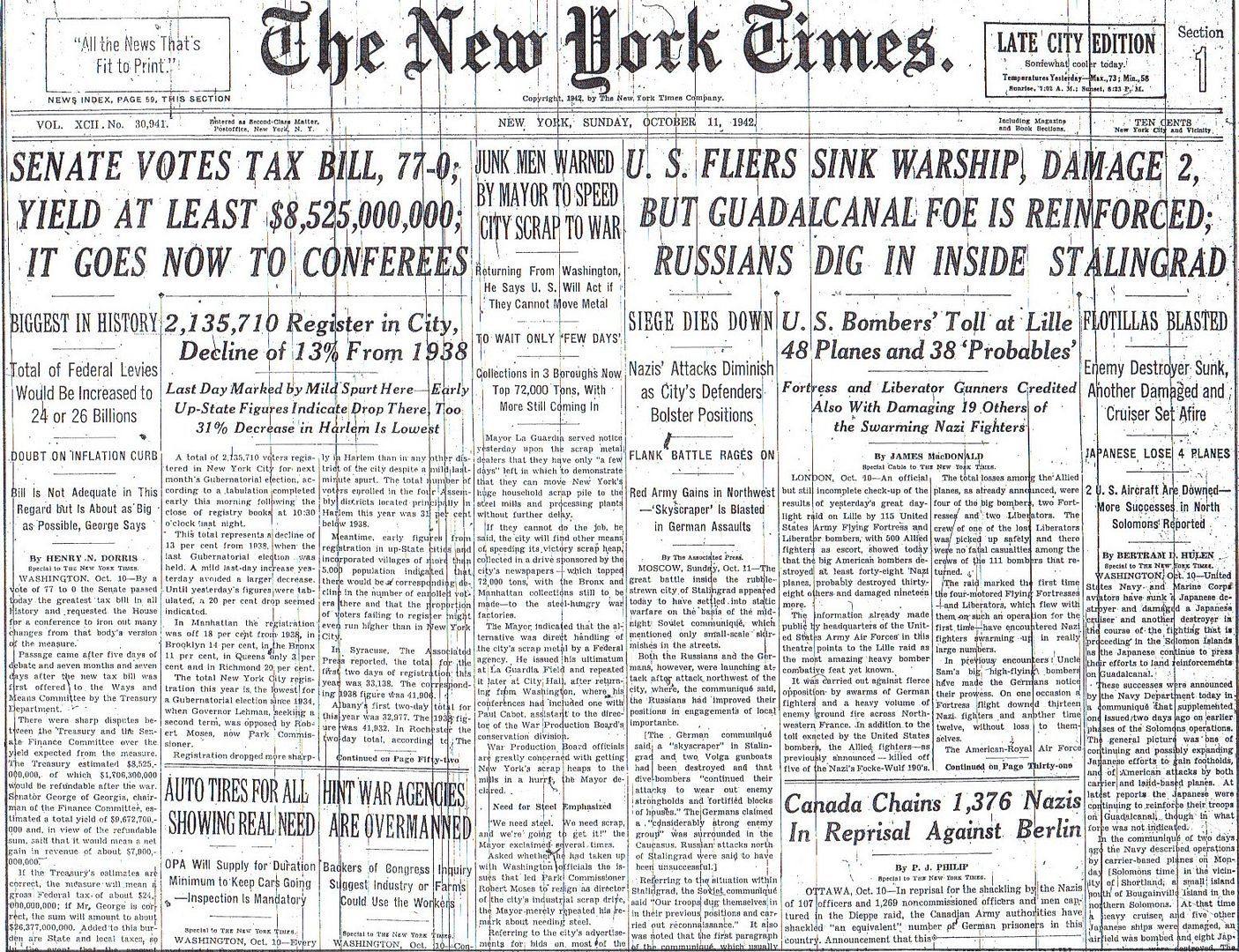
Posted on 10/11/2012 4:29:16 AM PDT by Homer_J_Simpson

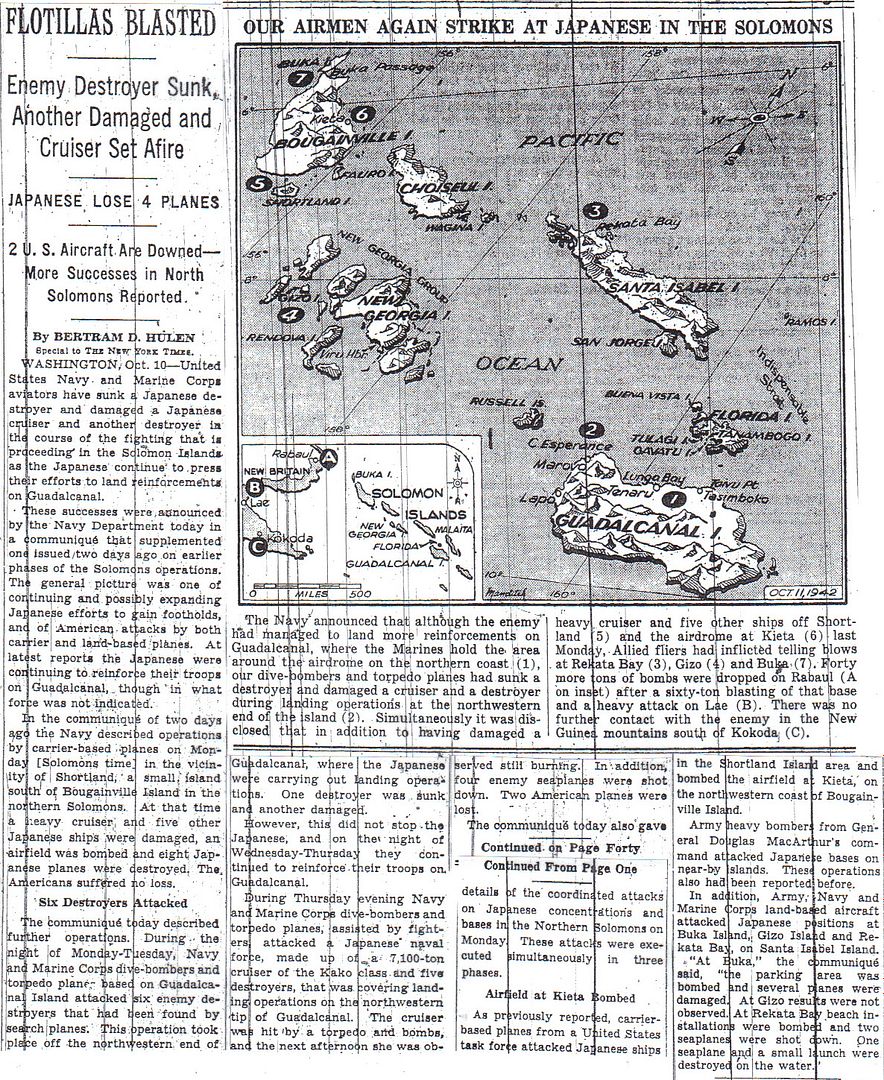
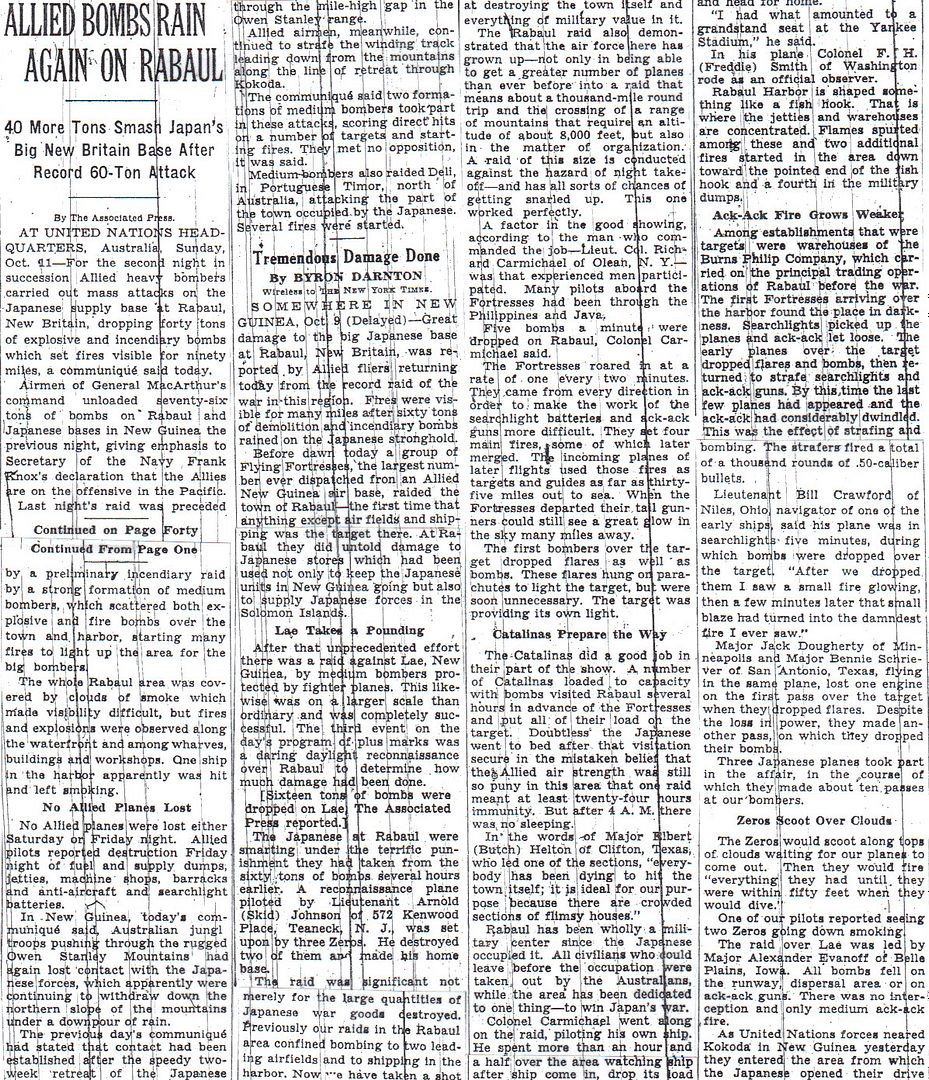
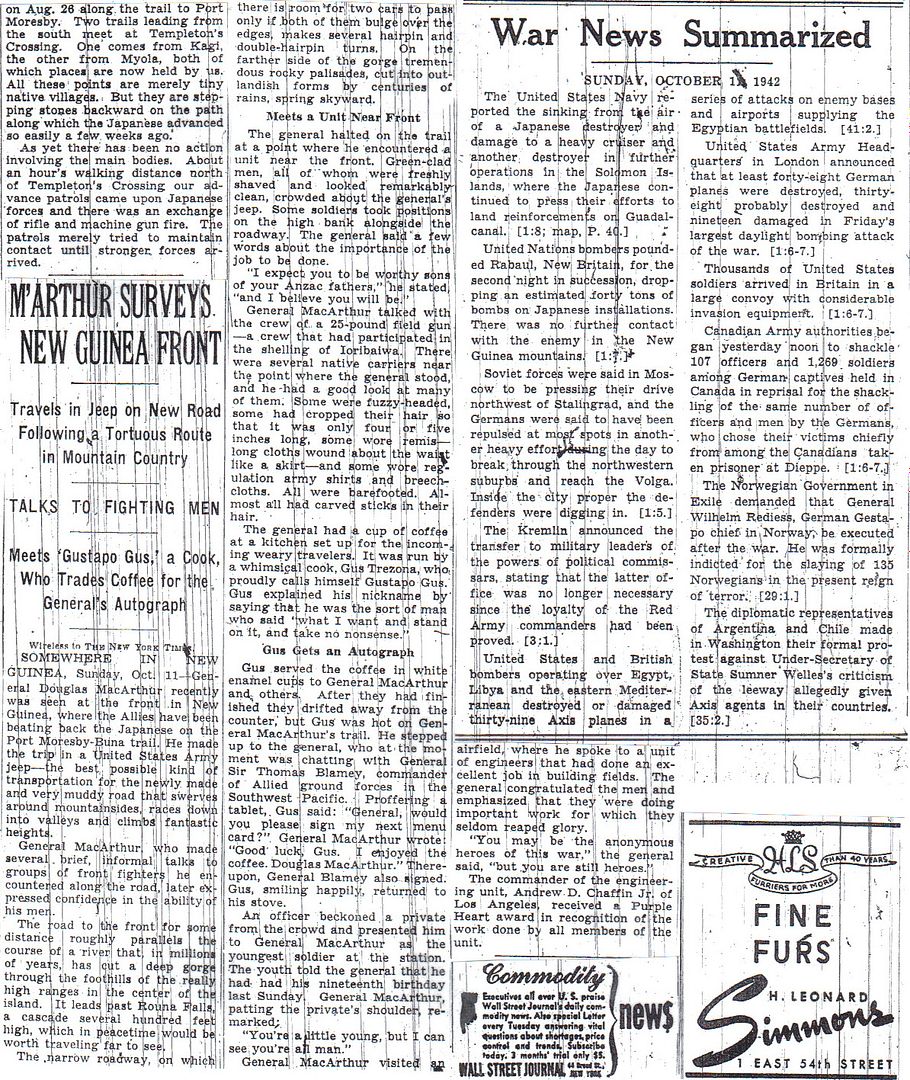
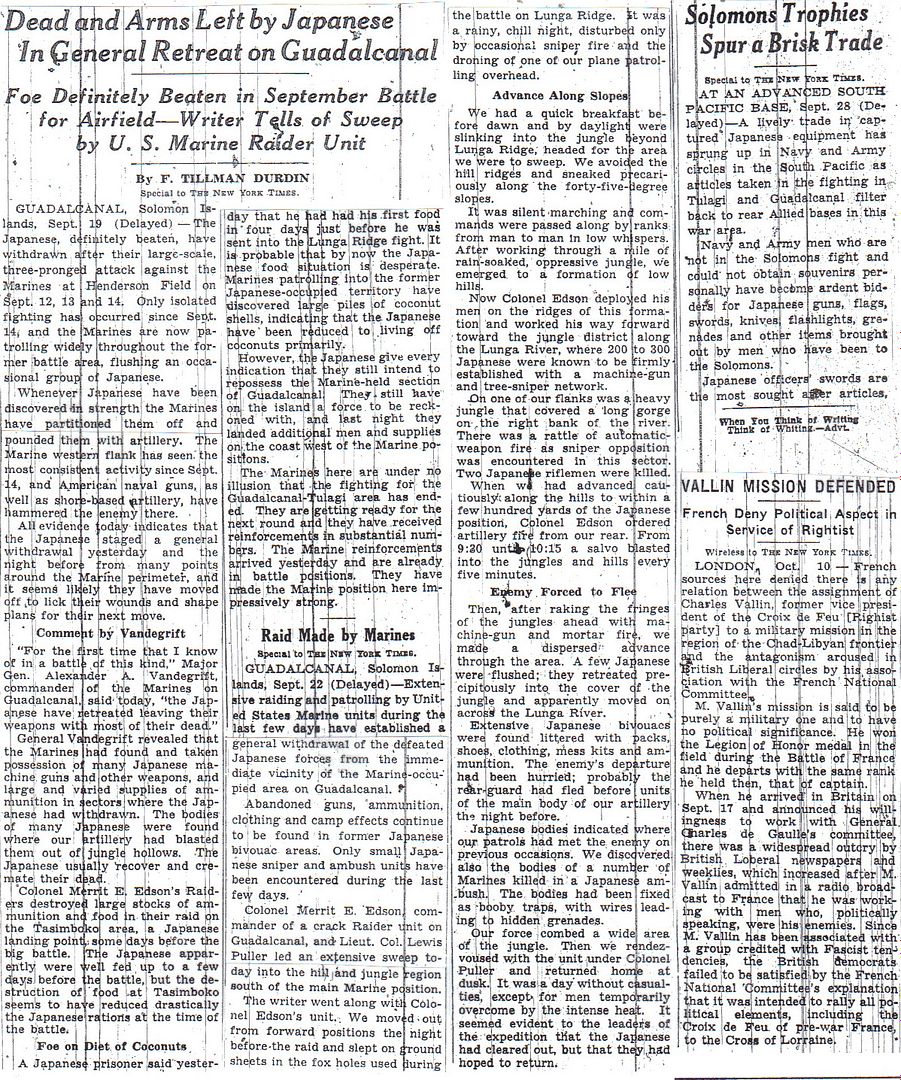

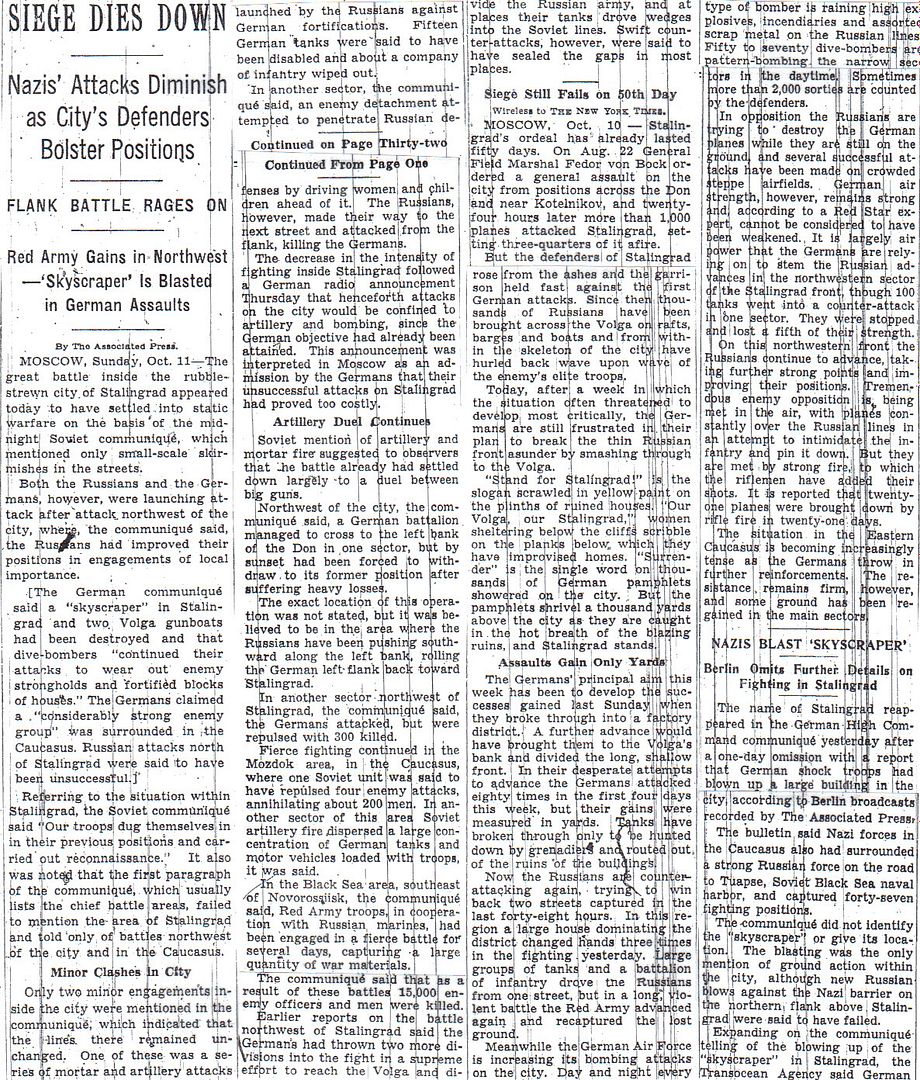

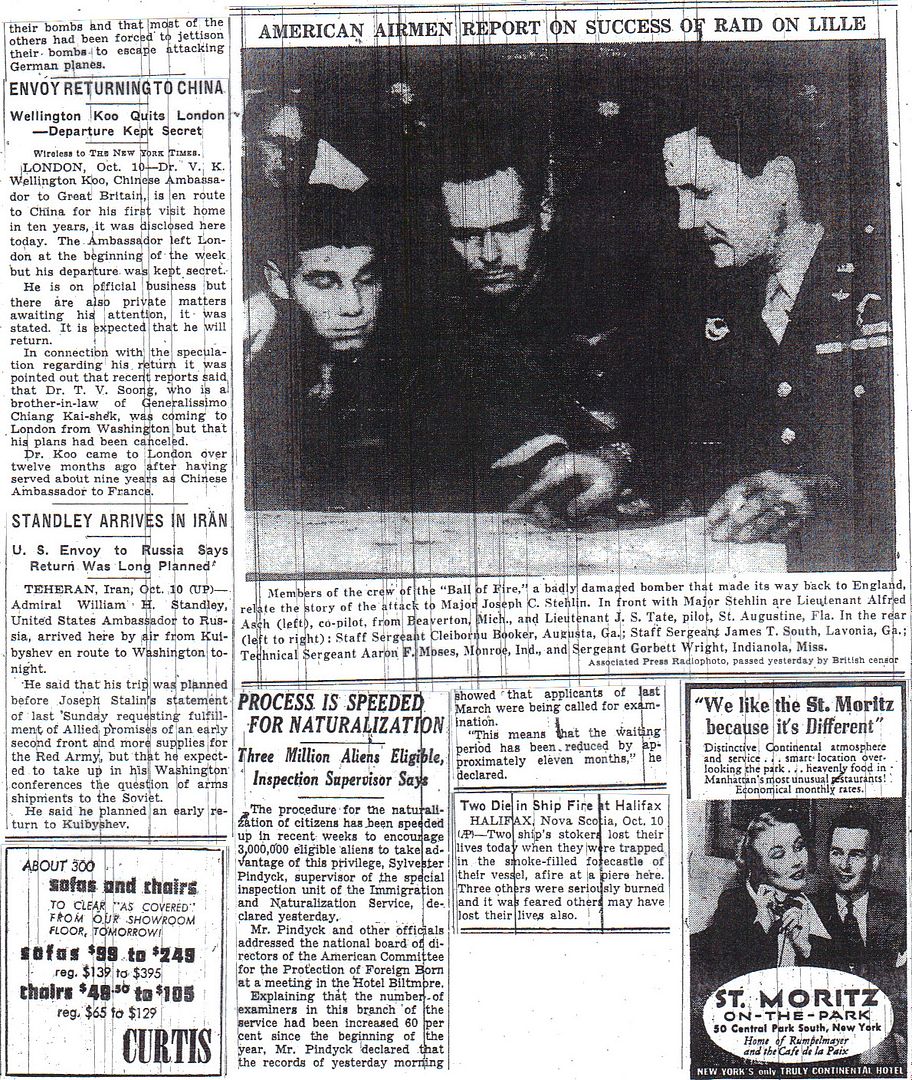
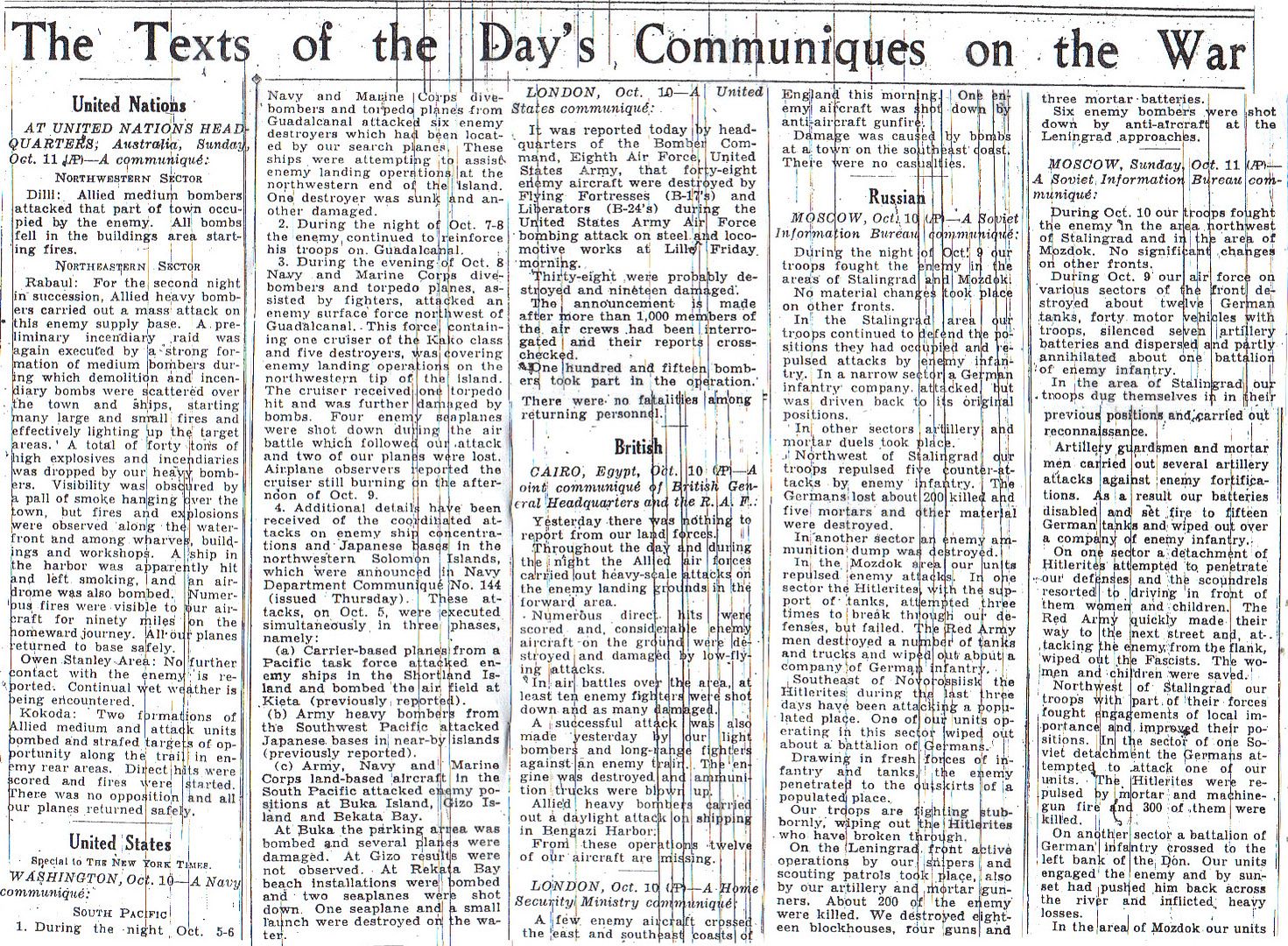
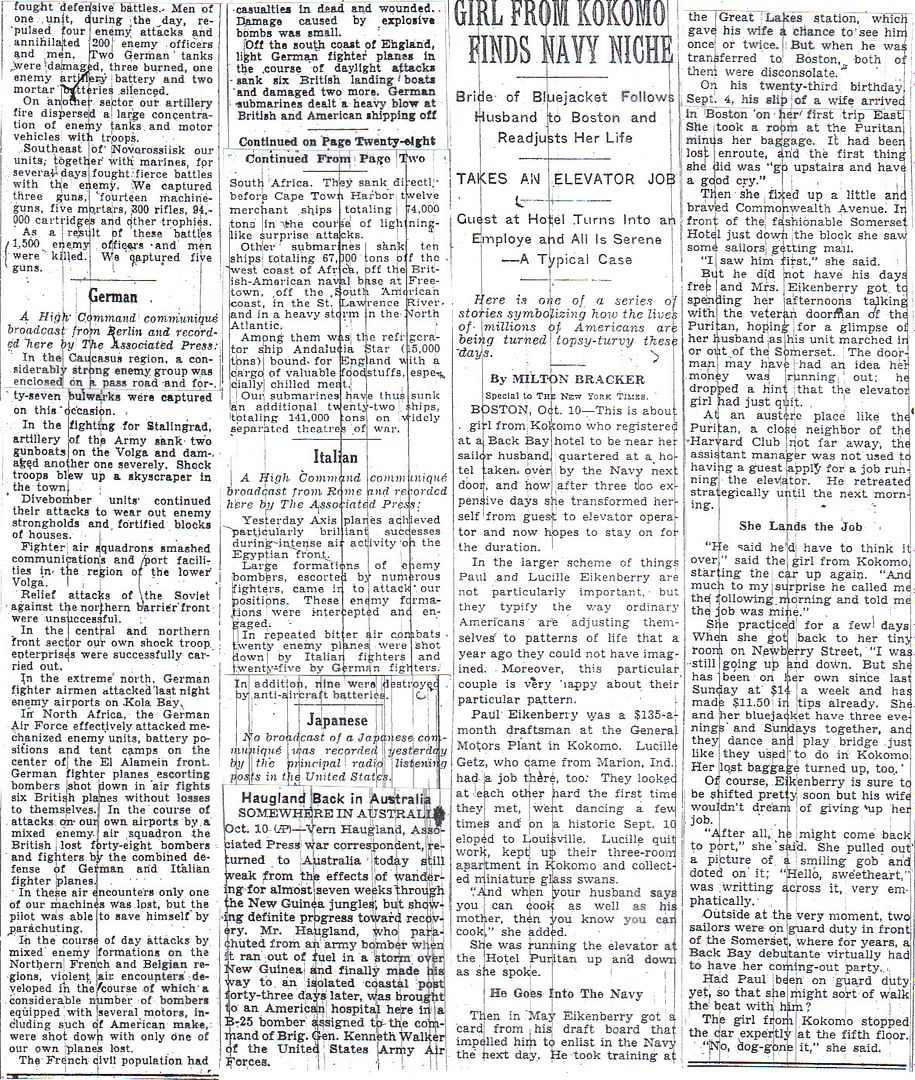

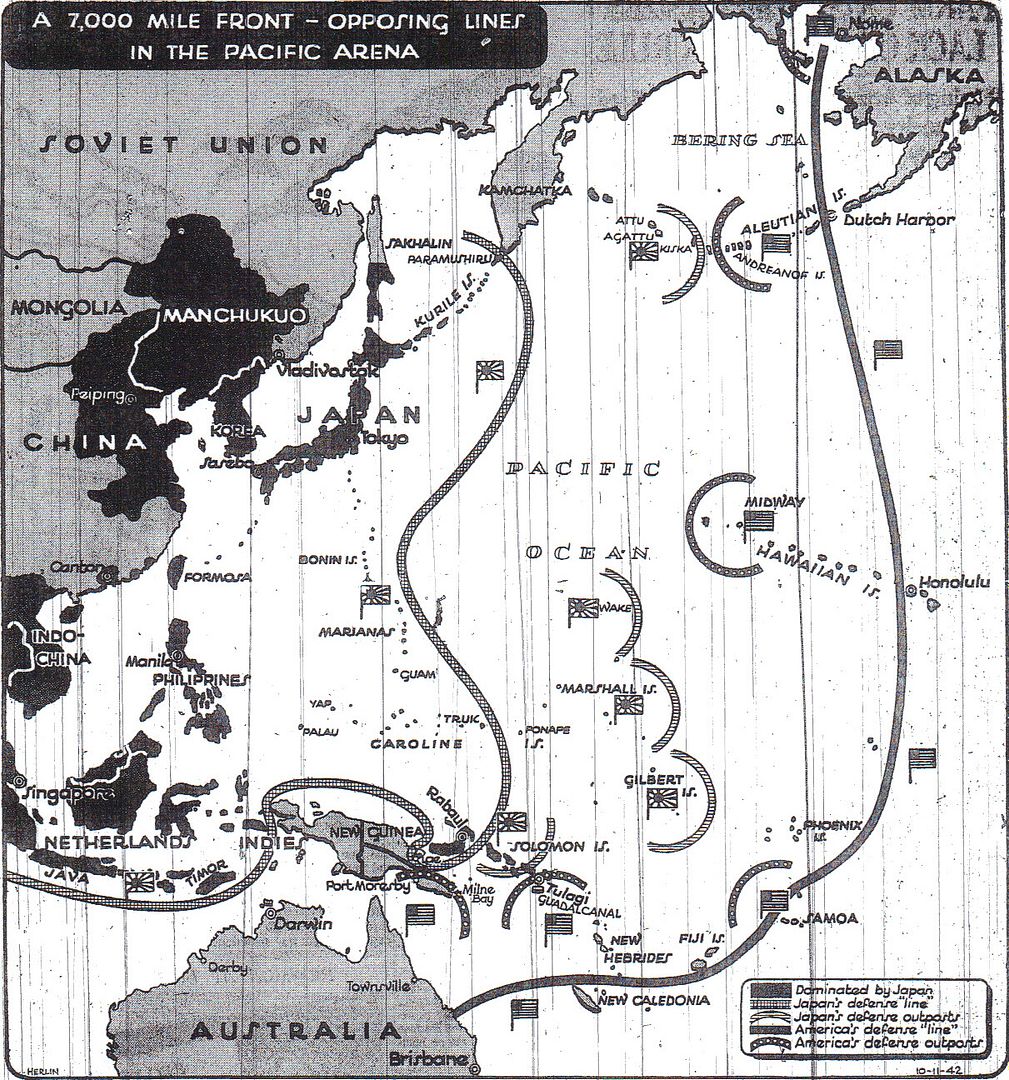
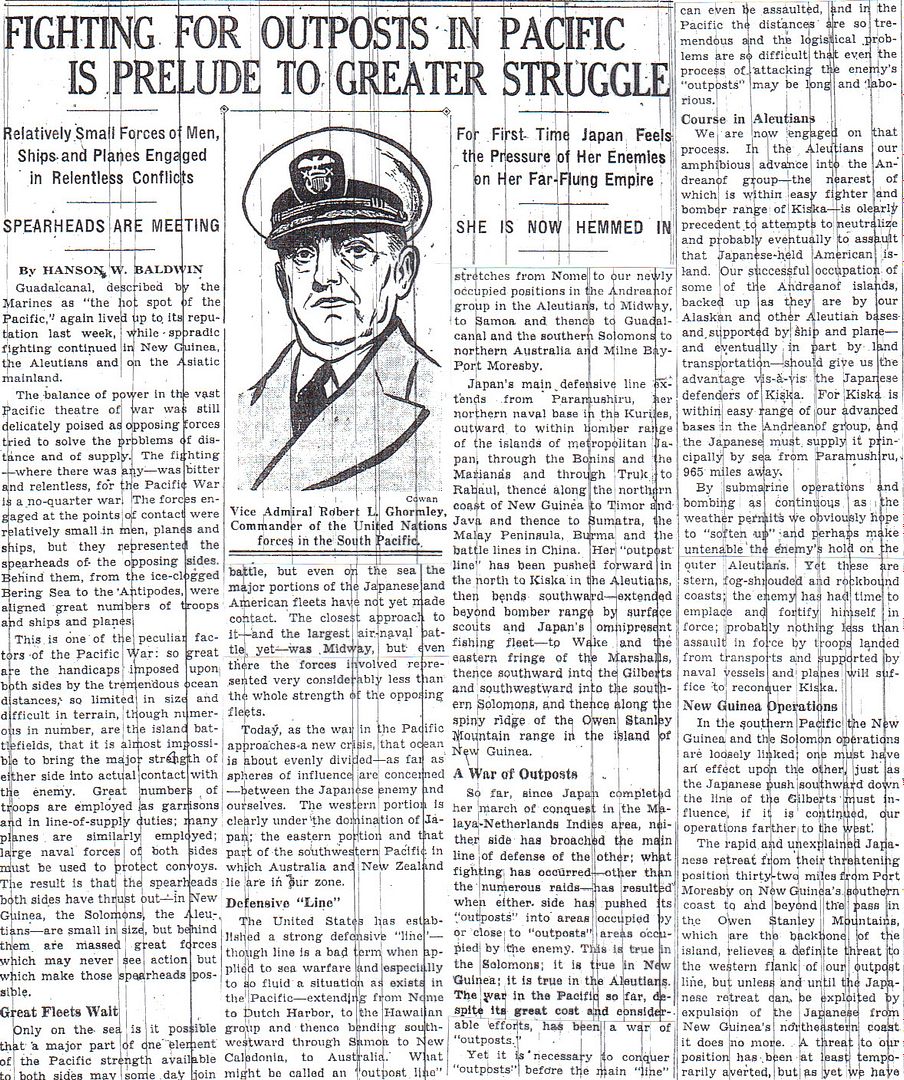
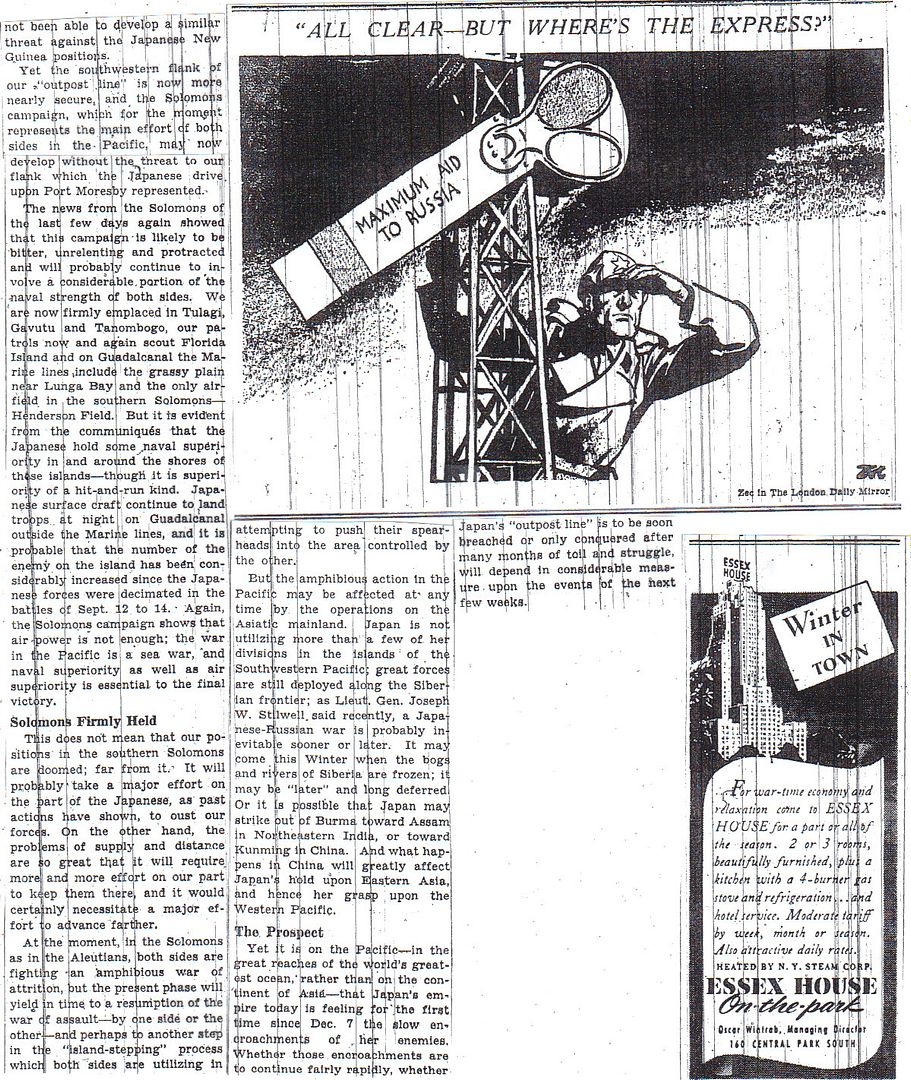
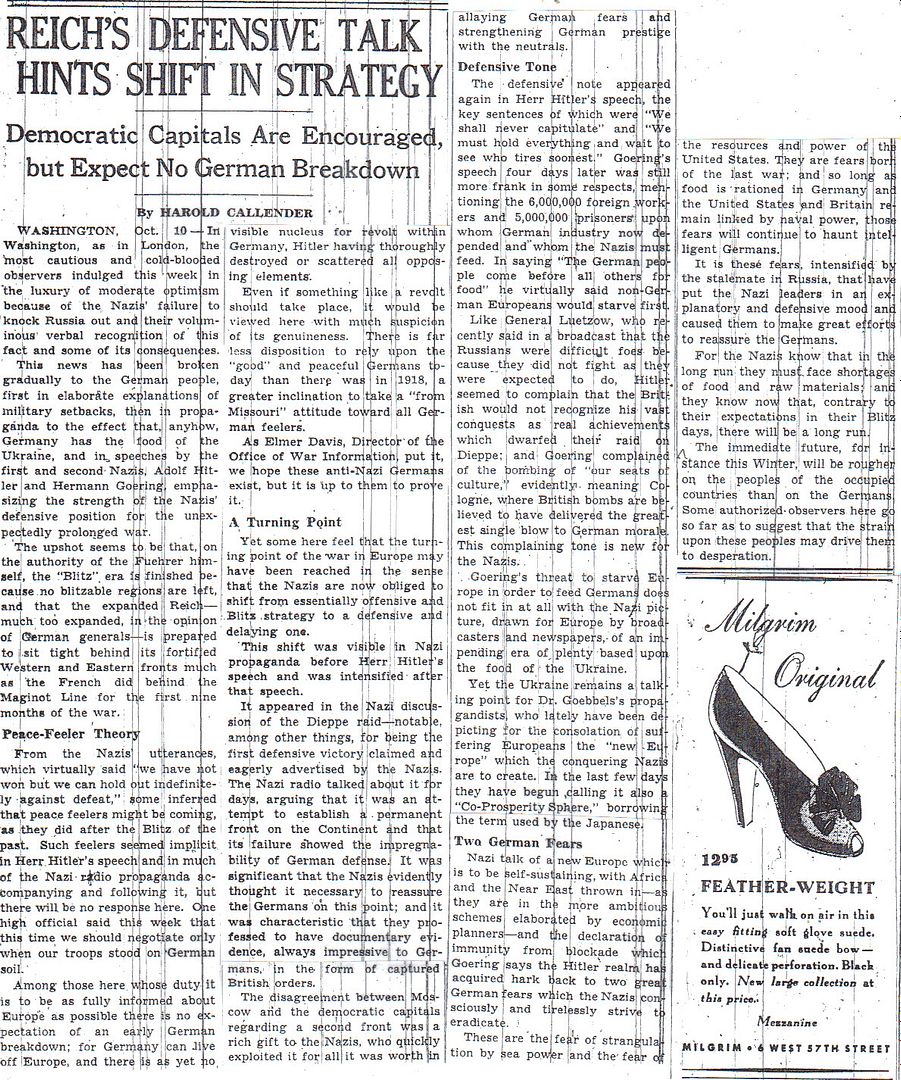
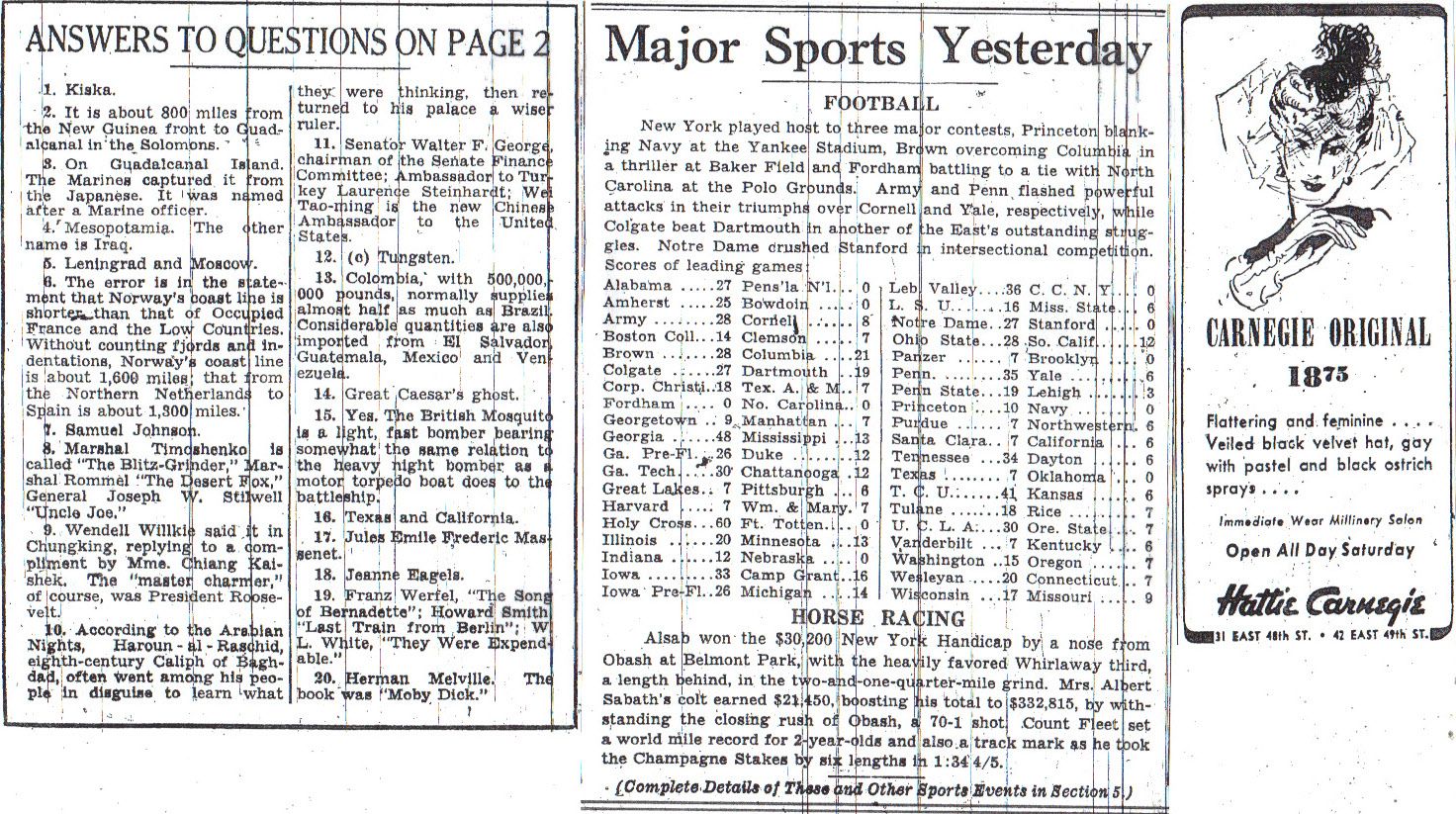
The News of the Week in Review
Twenty News Questions – 12
A 7,000 Mile Front-Opposing Lines in the Pacific Arena (map) – 13
Fighting for Outposts in Pacific is Prelude to Greater Struggle (by Hanson W. Baldwin) – 14-15
Reich’s Defensive Talk Hints Shift in Strategy (by Harold Callender) – 16
Answers to Twenty News Questions – 17
Major Sports Yesterday (from front page) – 17
http://www.onwar.com/chrono/1942/oct42/f11oct42.htm
Night fighting navies at Cape Esperance
Sunday, October 11, 1942 www.onwar.com
Heavy cruiser USS San Francisco survived the battle [photo at link]
In the Solomon Islands... The Battle of Cape Esperance. American and Japanese efforts to supply their troops fighting on Guadalcanal result in a night encounter between the escorting naval forces. The American escorts, led by Admiral Scott consists of 4 cruisers and 4 destroyers. The Japanese have 3 cruisers and 2 destroyers led by Admiral Goto. They meet at night off Cape Esperance. Despite the advantages of radar and better radio communications, the American fare as poorly as the Japanese, both at times firing on their own vessels. The Americans lose a destroyer and two cruisers in the fighting. The Japanese lose a cruiser and a destroyer with the two other cruisers badly damaged. Despite the battle, the Japanese manage to land artillery and tanks at their positions.
On the Eastern Front... A lull in the fighting for the first time in two months.
http://homepage.ntlworld.com/andrew.etherington/frame.htm
October 11th, 1942
UNITED KINGDOM: Submarine ORP Dzik (ex-HMS P-52) launched. (Dave Shirlaw)
U.S.S.R.: A lull in the fighting around Stalingrad is the first in almost two months, as both sides seek reinforcements.
Pacific Fleet: Submarine “L-16” is sunk by Japanese “I-25”, close to Cape Shumshu, approximately 500 miles west of Seattle, Washington, USA. All 50 aboard are killed. L-16 left Petropavlovsk with L-15 to join the Northern Fleet on 26 September 1942. The two submarines intended to sail through Dutch Harbor and San Francisco to the Panama Canal. The crew of L-15 witnessed the sinking. (Sergey Anisimov and Dave Shirlaw)(69)
Polar Fleet and White Sea Flotilla: Shipping loss. SKR “Musson” (ex-RT-54 “Sudak”) - mined in Matochkin Shar strait. (Sergey Anisimov)(69)
MEDITERRANEAN SEA: US Army, Middle East Air Force B-24s attack a convoy hitting one vessel and claiming one fighter shot down. (Jack McKillop)
SOLOMON ISLANDS: A Japanese transport force (Rear Admiral Joshima Koji), formed around seaplane carriers HIJMS Chitose and HIJMS Nisshin and six destroyers, reaches Tassafaronga, Guadalcanal, to disembark elements of the Japanese Army’s 2d Infantry Division. Three heavy cruisers and two destroyers (Rear Admiral Goto Aritomo, his flag in heavy cruiser HIJMS Aoba) are to provide cover by shelling Henderson Field.
USAAF B-17s sight the cruisers and destroyers bearing down on Guadalcanal Island in the afternoon. USN Task Force 64 (Rear Admiral Norman Scott) consisting of the heavy cruisers USS Salt Lake City (CA-25) and USS San Francisco (CA-38), light cruisers USS Helena (CL-50) and USS Boise (CL-47) and five destroyers has been formed to thwart the “Tokyo Express,” a steady flow of Japanese vessels maintaining reinforcement and re-supply to Guadalcanal.
At about 1615 hour local, the ships commenced a run northward from Rennel Island, to intercept an enemy force of two cruisers and six destroyers reported heading for Guadalcanal from the Buin-Faisi area.
The force continued north, to approach Savo Island from the southwest.
By 2330 hours, when the ships were approximately 6 miles (9.66 km) northwest of Savo, they turned to make a further search of the area.
A few minutes after setting the new course, radar indicates unidentified ships to the west, several thousand yards distant.
At about 2345, the Battle of Cape Esperance began.
Search planes were ordered launched from the cruisers, but in the process of launching, USS Salt Lake City’s plane caught fire as flares ignited in the cockpit. The plane crashed close to the ship and the pilot managed to get free. He later found safety on a nearby island. The brilliant fire was seen in the darkness by the Japanese flag officers, who assumed that it was a signal flare from the landing force which they were sent to protect. The Japanese flagship answered with blinker light, and receiving no reply, continued to signal.
The American force formed a battle line at right angles to the Japanese T-formation (crossed the T), and thus were able to enfilade the enemy ships. The American cruisers opened fire and continued scoring hits for a full 7 minutes before the confused Japanese realized what was taking place. They had believed that, by error, their own forces were taking them under fire.
When the Japanese warships replied, their fire was too little and too late. The action was over in half an hour.
The Americans sink heavy cruiser HIJMS Furutaka and destroyer HIJMS Fubuki and cripple heavy cruisers HIJMS Aoba and HIJMS Kinugasa; one destroyer of the five-ship force escapes damage.
After the battle, more than 100 of Fubuki’s survivors refuse to be rescued from shark-infested waters and are forcibly pulled onto two American ships. Among the Japanese dead is squadron commander Rear Admiral Aritomo Goto.
USS Salt Lake City sustained three major hits during the action; USS Boise was severely crippled, but managed to rejoin the group under her own power; and the destroyer USS Duncan (DD-485) was left gutted off Savo Island. The ships formed up and steamed to Espiritu Santo. (John Nicholas and Jack McKillop)
PACIFIC OCEAN: Japanese submarine HIJMS I-25, homeward bound from her deployment off the U.S. West Coast, torpedoes and sinks Russian submarine L 16 500 miles west of Seattle en route from Dutch Harbor, Alaska, to San Francisco, California. All 50 aboard were killed. L-16 left Petropavlovsk with L-15 to join the Northern Fleet on 26 September 1942. The two submarines intended to sail trough Dutch Harbor, San Francisco to the Panama Canal. The crew of L-15 witnessed the sinking. (Jack McKillop and Dave Shirlaw)
SOUTHWEST PACIFIC OCEAN: USN submarine USS Searaven (SS-196) torpedoes a German blockade runner in the Sunda Strait, Netherlands East Indies. (Jack McKillop)
TERRITORY OF ALASKA: ALEUTIAN ISLANDS: Japanese-held Kiska Island is hit by 3 bombing and strafing missions flown by 10 B-24 Liberators and 3 B-17 Flying Fortresses of the Eleventh Air Force; the B-17s make no contact; the B-24s blast harbor targets and Main Camp. (Jack McKillop)
AUSTRALIA: Minesweeper HMAS Kapunda commissioned. (Dave Shirlaw)
CANADA: Battle of the St. Lawrence - The Newfoundland-registered pulpwood bulk carrier Waterton (2,140 GRT) is torpedoed and sunk by U-106, KptLt Hermann Rasch, Knight’s Cross, CO, in the Cabot Strait, in position 47.07N, 059.54W.
Waterton had been part of the Cornerbrook, Newfoundland, to Sydney, Nova Scotia, convoy BS-31.
There was no loss of life in this incident.
Henry Asbjorn Larsen 1899-1964 sails the RCMP patrol vessel St Roch into Halifax after making the first west-to-east crossing of the NW Passage; one of his eight-man crew had died of a heart attack in the Arctic as the wooden sailing schooner with an auxiliary engine spent the winter in the ice less than 80 km from the North Magnetic Pole. The St. Roch was built in North Vancouver in 1928. A wooden schooner with sail and auxiliary engine, she left Vancouver in the summer of 1940, took the southerly route through the Arctic islands, and spent two winters trapped in the ice; she was the second ship to sail the Passage, after Amundsen’s Gjoa in 1908. She returned to Vancouver July-Oct. 1944 by the northerly Lancaster Sound route, and today you can see her berthed in Vancouver’s Maritime Museum. (Dave Shirlaw)
U.S.A.: Destroyer USS Foote launched. (Dave Shirlaw)
ATLANTIC OCEAN:
U-589 sank SS Musson.
U-615 sank SS El Lago in Convoy ONS-136.
U-87 sank SS Agapenor.
SS Caribou, passenger steamship enroute from North Sydney, Nova Scotia to Port aux Basques, Newfoundland was torpedoed by U-69, KptLt Jost Metzler, Knights Cross, CO, in the Cabot Strait. Minesweeper HMCS Grandmere attacked with depth charges but with no result. Of the 237 persons aboard Caribou, only 104 survived and were rescued by Grandmere. (Dave Shirlaw)
"Extra food was, to say the least, a significant event in the daily lives of starved camp inmates.
"Dividing the Bread in the Concentration Camp," a painting by Plaszow labor-camp survivor Joseph Bau, suggests the keen interest roused by unexpected windfalls."
"One of the things that distinguished Orthodox Jewish men was their beards.
Many, such as Rabbi Avraham Grodzensky (pictured), shaved their beards, violating Orthodox traditions.
He likely shaved it because Othodox men were more likely to be chosen and abused, even on the streets."
"Irma Grese, nicknamed the "Belle of Auschwitz," became a guard as a teenager and rose through the hierarchy to oversee nearly 20,000 women prisoners.
Grese took special pleasure in watching the doctors at Auschwitz perform disfiguring surgeries on women.
"The Ravensbrück, Germany, concentration camp for women contained a training camp to prepare women to become camp supervisors.
Some 3,500 women who trained at Ravensbrück served as guards there or at other camps.
Hildegard Mende (pictured) worked at Theresienstadt.
While a few guards exhibited kindness toward their prisoners, most followed the harsh camp rules, and beat and humiliated their prisoners.
Few sought to intercede on inmates' behalf.
Some guards even competed with one another in cruelty, believing that was the route to promotion and respect from their male superiors.
"One prisoner reported that women were even worse than men in commanding their dogs to brutally attack inmates.
Another prisoner attested that a female guard requested permission to watch the gassings at Auschwitz, a pastime she particularly enjoyed."
"The Jews of Biala Podlaska, Poland, are assembled prior to their deportation to a death camp.
On June 10, 1942, 3000 Jews were shipped to Sobibor.
A further 6200 were shipped to the death camp at Treblinka in September and October.
Biala Podlaska had a horrific history under Nazi rule: In January 1940 800 Polish POWs had been marched from an internment camp on Lipowa Street toward Biala Podlaska.
Because of winter cold and indiscriminate abuse and murder by the SS, only a few dozen of the POWs lived to reach the town."
"Not all concentration-camp inmates were determined to survive.
Devastated by the loss of loved ones, the inhuman conditions, and the barbarity they had witnessed, some chose to take their own lives.
Others were ordered by their guards to run into the electrified fences--perhaps the case for the Dutch Jew pictured here.
\ His life ended at the camp at Mauthausen, Austria, one of the harshest of the concentration camps."
"The abandoned furniture of the Wloclawek (Poland) Ghetto is the sole reminder of those Jews who called this place home after the 3000 residents were deported on April 22, 1942.
The stillness of the scene obscures the violence with which Jewish life in Wloclawek was tragically terminated."
"This chart outlines the appropriate forms of communication to be sent with each rail deportation of Jews.
Coordinating the "Final Solution" was a tremendous logistical operation.
Scheduling trains, selecting individuals for deportation, and determining where to send each shipment required a complex and sophisticated bureaucracy.
It was important, therefore, to standardize the forms used to detail the shipping information that accompanied every train sent to a Nazi concentration camp or extermination center."
BIGGEST IN HISTORY
Total of Federal Levies
Would be Increased to
24 or 26 Billions"
Not that anyone on Free Republic ever needs reminding, but for whatever else World War Two was, for Liberal Democrats it was absolute political Nirvana, high political orgasmic heaven, a time of 72 conservative virgins for every liberal voter -- nothing could make them happier than daily headlines of tax increases, more tax increases, the most tax increases ever on all those nasty, nasty people who have all the money!
And nothing today makes them more nostalgic for those "good old days", back in the time when it was all about, indeed only about one form of socialism versus another -- back in the time when National Socialists fought International Socialists supported by Allied more-or-less Democratic Socialists.
Back in the day... when the only real conservatives were out where conservatives belong: getting killed on the front lines, while their wives & sweethearts worked in war-factories to make the stuff to keep them fighting.
Oh, to be a Liberal Democrat Socialist in such a time again... and why can't we go back to it?
All we need is a few more government industry take-overs to ruin the free economy, and we'll just have to vote more taxes to keep the government going...
*********************
End of today's rant... ;-)
My understanding is that a soldier taking such trophy now would be charged with theft.
Just wait until they start collecting ears.
In the Pacific, the prized souveneir was the samurai sword. In Europe it was the Luger. A lot of guys came home with live enemy ammunition such as mortar rounds. As they are passing away today, these “trophies” are being found in attics where they have sat for decades. It makes interesting work for the local bomb squads to dispose of them.
But yes, they don’t let our soldiers do this stuff today. Can’t even piss on your dead enemies any more.
I consider Cape Esperance to be an American victory. One IJN heavy cruiser sunk, and two damaged. All American crusiers will be repaired and return to active duty. Admiral Scott showed he could handle night fighting, and had a force trained for the job. Unfortunately, he is about to be outranked by Admiral Callaghan, who arrived with USS San Francisco. More on that later.
In reading the Times in the past few weeks, you have to ask “just how many heavy cruisers do the Japanese have?” It seems every other day there is a report of damage or sinking of an IJN heavy cruiser. Well, the Japanese did have a lot of them. And while several are being sunk, many others are being damaged.
A very good source for IJN unit histories, as most of you know, is:
http://www.combinedfleet.com/kaigun.htm
I was reading through the unit histories of the IJN heavy cruisers today, and it’s amazing how many of them suffered serious battle damage during this time, and were being shipped back to Japan for repairs and being sent out into combat again. Two points I would make about that.
1. There are a considerable number of ships tying up the Japanese yards with repairs, and new naval construction is almost non-existent.
2. The Japanese are patching up these ships as fast as they can to return them to combat. I’m guessing that a good many of these repairs are not returning the ships to their full fighting form. For example, the Japanese did not replace the damaged 8” gun turret on Aoba, but rather welded steel plates over it and put a 25mm AA gun on top. Instead of upgrading these ships in the yards, they are going back out less battle-worthy than before.
Sorry, didn’t see your post earlier. I have about the same opinion of Cape Esperance.
I assume you’ve read Richard Frank’s “Guadalcanal,” which has an excellent account of Cape Esperance. The American light cruisers Boise & Helena gave a very good account of themselves, both in ability to dish it out and take it. With their excellent radar, fire control systems and automatic loading, we would have done well to use more of them in the night engagements around Savo Island.
Yes! Hoosiers defeat Nebraska, 12-0! Oh, how the world has changed in the past 70 years, and not for the better!
In the vast geographic expanse that is WW2, there are two stories that appear totally unrelated, but actually are. In one, at Stalingrad it appears the Germans have complete air supremacy, and are relying much on their air power to support their ground operations in the fighting. It has become apparent just how important air power is on the battlefield. In the other story, American bombers are ramping up their daylight raids over Europe, and are claiming a lot of German fighters. Of course, the claims are wildly exaggerated.
The connection though, is that the Germans are going to have to devote more daylight fighters to the defense of their airspace over Western Europe and the Reich. Those fighters will have to be drawn from other theaters, particularly the Eastern Front. Without fighter protection, the Germans lose their air supremacy over the Soviets. I wonder if people in 1942 are making the connection.
Our radar fire control was a real equalizer when facing the Japanese at night. Without it they were far superior in night fighting.
But only if you know how to utilize it...
In Herman Wouk’s fictionalized account of the battle off Tassafaronga Point on November 30 the Japanese got an edge because the Americans didn’t use flashless powder. So the Japanese knew where to send their torpedoes as soon as the Americans opened fire. Does that jive with the historical record?
I will give you my recollection of what I’ve read since I’m at work. It wasn’t the gun flashes, it was American incompetence. The radar clearly had the Japanese spotted, but the Americans held their fire. The Japanese had much better night vision, and once they spotted the American force, they knew exactly what to do. They launched their fish well before the Americans opened fire.
Everything you said and very long range and accurate torpedoes and excellent sailors
Disclaimer: Opinions posted on Free Republic are those of the individual posters and do not necessarily represent the opinion of Free Republic or its management. All materials posted herein are protected by copyright law and the exemption for fair use of copyrighted works.